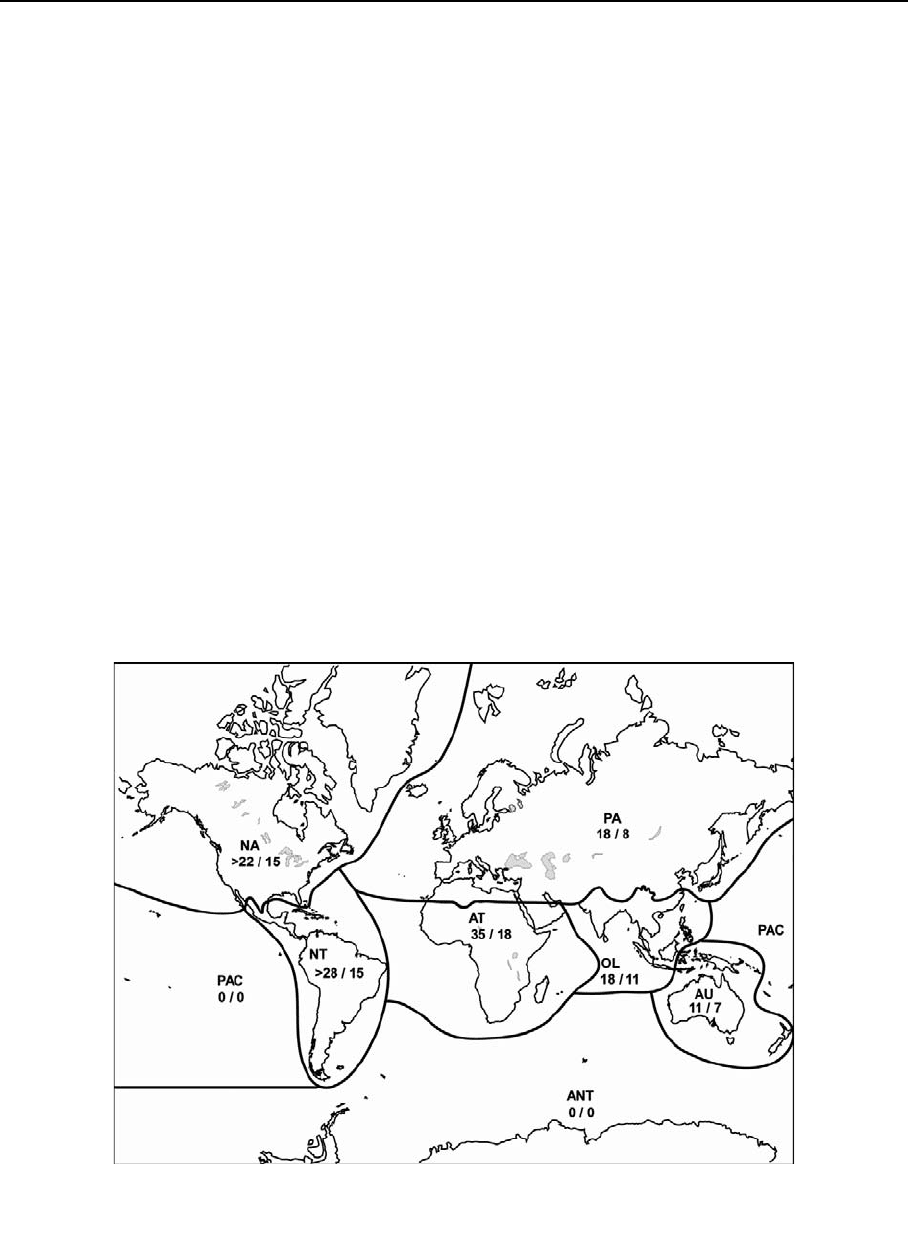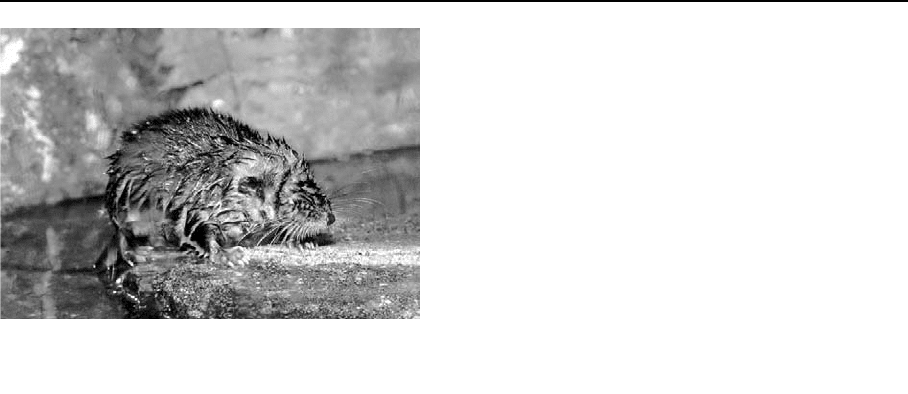Balian E.V., L?v?que C., Segers H., Martens K. (Eds.) Freshwater Animal Diversity Assessment
Подождите немного. Документ загружается.


use in leather trade of not less than ten freshwater snake
species. In western central Africa, Grayia ornata plays
an important role in local culture, food, traditional
medicine and magic (Pauwels et al., 2002). Besides
local overcollecting, the main threats to conservation
might come from intensive logging and freshwater
habitat degradation. Field studies on the most localized
species (e.g., some Enhydris spp.) would be necessary
to evaluate specific threats. Most freshwater snakes are
harmless, but some are poisonous among the Elapidae,
Homalopsidae and Viperidae. Boulengerina venoms
have not been studied so far, and there thus exists no
specific antivenom, although the venom might have a
strong neurotoxic action (Spawls & Branch, 1995), like
Micrurus surinamensis, Hydrophis spp. and Laticauda
spp. Although venomous, Homalopsidae are rear-
fanged and do not represent a medical problem; none
is deadly. Agkistrodon piscivorus’s bite is potentially
lethal to humans.
References
Anonymous, no date. The EMBL Reptile Database. http://www.
embl-heidelberg.de/*uetz/LivingReptiles.html.
Boulenger, G. A., 1913. The Snakes of Europe. Methusen &
Co. Ltd., London.
Cei, J. M., 1993. Reptiles del noroeste, nordeste y este de la
Argentina. Herpetofauna de las selvas subtropicales, puna
y pampas. Museo regionale di Scienze naturali, Torino,
Monografie 14: 1–949, pl. 1–126.
Cogger, H. G., H. Heatwole, Y. Ishikawa, M. McCoy, N.
Tamiya & T. Teruuchi, 1987. The status and natural his-
tory of the Rennell Island sea krait, Laticauda crockeri
(Serpentes: Laticaudidae). Journal of Herpetology 21:
255–266.
do Amaral, A. P. B., 1978. Serpentes do Brasil. Iconografia
colorida—Brazilian snakes: a color iconography. 2a ed.
Ed. Melhoramentos & Editoria da Universidade de Sa
˜
o
Paulo, Sa
˜
o Paulo.
Fuchs, K. & M. Fuchs, 2003. Die Reptilhaut. Ein wichtiger
Merkmalstra
¨
ger bei der Identifizierung von Echsen und
Schlangen. The reptile skin. A key-feature in the identification
of lizards and snakes. Edition Chimaira, Frankfurt am Main.
Ineich, I., 1996. Hydrophis torquatus diadema. Herpetological
Review 27: 154.
Lawson, R., J. B. Slowinski, B. I. Crother & F. T. Burbrink,
2005. Phylogeny of the Colubroidea (Serpentes): new
evidence from mitochondrial and nuclear genes. Molec-
ular Phylogenetics and Evolution 37: 581–601.
Manthey, U. & W. Grossmann, 1997. Amphibien & Reptilien
Su
¨
dostasiens. Natur und Tier-Verlag, Mu
¨
nster.
Murphy, J. C. & H. K. Voris, 2005. A new Thai Enhydris
(Serpentes: Colubridae: Homalopsinae). Raffles Bulletin
of Zoology 53: 143–147.
Pauwels, O. S. G., P. David, W. Nutphand & C. Chimsunchart,
2001. First record of Xenochrophis punctulatus (Gu
¨
nther,
1858) (Serpentes: Colubridae: Natricinae) from Thailand.
Hamadryad 26: 259–264.
Table 1 continued
Taxa/Region PA NA NT AT OL AU WORLD
Micrurus (70) 1 1
Hydrophiinae
Hydrophis (29) 3 3
Laticauda (7) 11
HOMALOPSIDAE
Cantoria (2) 11
Cerberus (2) 11 1
Enhydris (23) 22 1 23
Erpeton (1) 11
Heurnia (1) 11
Homalopsis (1) 1 1
VIPERIDAE
Crotalinae
Agkistrodon (4) 1 1
Total species 6 22 39 19 64 7 153
Total genera 5 6 13 8 12 7 44
Genera are followed between brackets by the total number of species they contain. Brackish and sea water species are considered if
they also tolerate pure freshwater. PA: Palaearctic; NA: Nearctic; NT: Neotropical; AT: Afrotropical ; OL: Oriental; AU:
Australasian; PAC: Pacific Oceanic Islands; ANT: Antarctic
604 Hydrobiologia (2008) 595:599–605
123

Pauwels, O. S. G., A. Kamdem Toham & V. Mamonekene,
2002. Ethnozoology of the dibomina (Serpentes: Colu-
bridae: Grayia ornata) in the Massif du Chaillu, Gabon.
Hamadryad 27: 136–141.
Roze, J. A., 1996. Coral snakes of the Americas: biology,
identification, and venoms. Krieger Publishing Co.,
Malabar, Florida.
Spawls, S. & B. Branch, 1995. The Dangerous Snakes of
Africa. Natural History, Species Directory, Venoms and
Snake Bite. Blandford, London.
Stuart, B. L., J. Smith, K. Davey, P. Din & S. G. Platt, 2000.
Homalopsine watersnakes: the harvest and trade from
Tonle Sap. Traffic Bulletin 18: 115–124.
Vogel, G., P. David, O. S. G. Pauwels & N. Brachtel, 2004. On
the occurrence of the watersnake Sinonatrix aequifasciata
(Barbour, 1908) (Serpentes, Colubridae, Natricinae) in
Vietnam. Hamadryad 29: 110–114.
Voris, H. K., M. E. Alfaro, D. R. Karns, G. L. Starnes, E.
Thompson & J. C. Murphy, 2002. Phylogenetic relation-
ships of the Oriental-Australian rear-fanged water snakes
(Colubridae: Homalopsinae) based on mitochondrial
DNA sequences. Copeia 2002: 906–915.
Zhou, Z. & Z. Jiang, 2005. Identifying snake species threatened
by economic exploitation and international trade in China.
Biodiversity and Conservation 14: 3525–3536.
Hydrobiologia (2008) 595:599–605 605
123

FRESHWATER ANIMAL DIVERSITY ASSESSMENT
Global diversity of mammals (Mammalia) in freshwater
Geraldine Veron Æ Bruce D. Patterson Æ
Randall Reeves
Springer Science+Business Media B.V. 2007
Abstract Species that are dependant on, or adapted
to, freshwater environments are found in almost all
mammalian orders, and two orders, the Cetacea and
the Sirenia, are strictly aquatic and include some
freshwater-dependant species. Overall, the aquatic
and freshwater-dependant species represent around
70 of the more than 1,200 living or rece nt genera
of mammals, and occur in all continents except
Antarctica. They include some of the most
endangered species of mammals, and several have
gone extinct or become critically endangered in
recent decades. One of the main threats is habitat loss
or degradation. This chapter provides an overview of
the freshwater species within each order of mammals,
their evolutionary history, their relations to humans
and their conservation status.
Keywords Mammalia Freshwater
Diversity Conservation
Introduction
The mammals are tetrapod vertebrates characterized
by their jaw articulation (between the dentary and the
squamosal), presence of three bones in the middle ear
(malleus, incus, and stapes), mammary glands that
produce milk, and presence of hair. Living forms are
divided into three clades, the monotremes (Monotre-
mata), the marsupials (Metatheria), and the placentals
(Eutheria). Mammals have adapted to most kinds of
habitat and have assumed various modes of exis-
tence—terrestrial, arboreal, aerial, fossorial, and
aquatic, and inhabit all regions of the wor ld. At least
some forms in most of the orders depend on water for
habitat and food, many also for protection from
predators. Two orders, the Cetacea and the Sirenia,
are strictly aquatic. For most partially or semi-aquatic
mammals, at least giving birth or rearing of the young
takes place outside the water.
Guest editors: E. V. Balian, C. Le
´
ve
ˆ
que, H. Segers & K.
Martens
Freshwater Animal Diversity Assessment
Electronic supplementary material The online version of
this article (doi:10.1007/s10750-007-9122-1) contains supple-
mentary material, which is available to authorized users.
G. Veron (&)
De
´
partement Syste
´
matique et Evolution, Muse
´
um
National d’Histoire Naturelle, CP 51, USM 601-UMR
CNRS 5202, Origine, Structure et Evolution de la
Biodiversite
´
, 57 Rue Cuvier, 75231 Paris Cedex 05,
France
e-mail: veron@mnhn.fr
B. D. Patterson
Department of Zoology, Field Museum of Natural
History, 1400 S. Lake Shore Drive, Chicago, IL 60605-
2496, USA
R. Reeves
Okapi Wildlife Associates, 27 Chandler Lane, Hudson,
Quebec, Canada JOP 1HO
123
Hydrobiologia (2008) 595:607–617
DOI 10.1007/s10750-007-9122-1

Species diversity and geographical distribution
Freshwater mammals occur on all continents except
Antarctica, some species widely distributed but many
with very restricted ranges (Fig. 1). Many are
threatened and these are listed in Table 1 with
information on their distribution.
Order Monotremata (2 famili es; Groves, 2005)
Among the five species of living monotremes, the
duck-billed platypus (Ornithorhy nchus anatinus)
lives in streams, lakes and lagoons in easter n Australia
and Tasmania, but it has been extirpated from much of
its range due to hunting and habitat degradation, river
fragmentation from dams, and entrapment or entan-
glement in fishing gear (Nowa k, 1999).
Metatheria (or Marsupialia) (7 Orders, 22
families; Wilson & Reeder, 2005)
Among the 331 species of metatherians, the only
truly semi-aquatic species is the So uth American
water opossum (Chironectes minimus). It possesses
webbed feet and differs from other marsupi als in
having its rear-facing pouch equipped with a sphinc-
ter muscle to make it watertight for the attached
young (Marshall, 1978). The thick-tailed opossum
(Lutreolina crassicaudata) is an excellent swimmer
that exploits wetlands for food and nesting habitat
(Nowak, 1999).
Eutheria (placental mammals)
Order Chiroptera (1116 species in 18 families;
Simmons, 2005): Many bats are associated with fresh
water but one group, the fishing bats (Noctilio
albiventris and Noctilio leporinus), belonging to the
family Noctilionidae, feed on aquatic insects, and N.
leporinus also eats fish, frogs, and crustaceans. Like
other bats, they use echolocation to locate prey,
detecting the ripples on the water surface (Schnitzler
et al., 1994). They can swim and take flight from the
water (Revenga & Kura, 2003). Several species of
vesper bats (Vespertilionidae) share the enla rged hind
legs and claws of noctilionids, including Myotis
(Pizonyx) vivesi of Mexico, Myotis adversus of
Fig. 1 Species and genus number of freshwater (aquatic and
water dependent) mammals by zoogeographic region : species
number/genus number. PA: Palearctic Region; NA: Nearctic
Region; AT: Afrotropical Region; NT: Neotropical Region;
OL: Oriental Region; AU: Australasian Region; PAC: Pacific
Region and oceanic islands, ANT: Antarctic Region
608 Hydrobiologia (2008) 595:607–617
123

Table 1 The most threatened freshwater mammals (2006 IUCN Red List, including species in categories higher than lower risk;
subspecies and subpopulations are not included)
Taxon IUCN Red List status Distribution
Order Didelphimorphia
Chironectes minimus Near threatened Central and South America
Order Soricomorpha
Chimarrogale hantu Critically endangered South East Asia (tropical forest of Malay peninsula)
Chimarrogale phaeura Endangered South East Asia (tropical forest of Borneo)
Chimarrogale sumatrana Critically endangered South East Asia (tropical forest of Sumatra)
Desmana moschata Vulnerable Central Eurasia
Galemys pyrenaicus Vulnerable West Europe (Pyrenees and Northern mountains of
Iberian Peninsula)
Order Afrosoricida
Potamogale velox Endangered Tropical Africa
Micropotamogale lamottei Endangered West Africa (Mount Nimba in Guinea, Liberia,
Ivory Coast)
Micropotamogale ruwenzorii Endangered Central Africa (Uganda, Zaire)
Limnogale mergulus Endangered East Madagascar
Order Lagomorpha
Bunolagus monticularis Critically endangered South Africa (Cape Province)
Order Rodentia
Castor fiber Near threatened Eurasia
Dasymys foxi Vulnerable Africa (endemic to South plateau of Nigeria)
Dasymys montanus Vulnerable Africa (endemic to Ruwenzori Mountains, Uganda)
Dasymys nudipes Near threatened Africa (S Angola, South West Zambia, North East
Namibia, North Botswana)
Pelomys hopkinski Vulnerable Africa (Rwanda, Uganda, South West Kenya)
Pelomys isseli Endangered Africa (endemic to islands of Lake Victoria,
Uganda)
Nectomys parvipes Critically endangered South America (known only from Comte River,
French Guiana)
Ichthyomys pittieri Vulnerable South America (North Venezuela)
Neusticomys mussoi Endangered South America (known only from Paso Hondo, Rio
Potosi, Venezuela)
Neusticomys oyapocki Endangered South America (known only from Trois sauts,
French Guyana)
Neusticomys peruviensis Endangered South America (known only from Balta, Peru)
Nectomys parvipes Critically endangered South America (known only from Cacao, Comte
River, French Guyana)
Mesocapromys angelcabrerai Critically endangered Cuba
Mesocapromys auritus Critically endangered Cuba
Mesocapromys nanus Critically endangered Cuba
Mesocapromys sanfelipensis Critically endangered Cuba
Order Carnivora
Mustela lutreola Endangered Europe (in isolated small populations)
Aonyx congicus Data deficient Equatorial Africa (distribution scarce and not fully
known)
Lutra lutra Near threatened Eurasia
Lontra longicaudis Data deficient Central and South America
Hydrobiologia (2008) 595:607–617 609
123

Australia, and Myotis ricketti of China, and are
known to eat fish (Ma et al., 2003), often being
included among the fishing bats.
Order Afrosoricida (51 species in 2 families;
Bronner & Jenkins, 2005): The Tenrecidae includes
some semi-aquatic forms. The otter shrews are
represented by three African species (giant otter
shrew, Potamogale velox, Nimba otter shrew Micro-
potamogale lamottei, and Ruwenzori otter shrew
Micropotamogale ruwenzorii) with restricted distri-
butions in the Congo Basin and Equatorial Africa.
The remaining Tenrecidae are endemic to
Madagascar. Some species live in marshy areas or
burrow in banks of rice paddies, while the aquatic or
web-footed tenrec (Limnogale mergulus) lives along
large fast-flowing rivers and feeds mainly on aquatic
invertebrates (Benstead & Olson, 2003, Fig. 2,
Tables 2 and 3).
Order Soricomorpha (428 species in 4 families;
Hutterer, 2005): The water shrews live in boreal
North America (Blarina brevicauda, Sorex palustris,
Sorex bendirii, and Sorex alaskanus), in Southeast
Asia (Nectogale elegans, Chimarrogale, six species),
and in the Palearctic (Neomys, three species). Water
Table 1 continued
Taxon IUCN Red List status Distribution
Lutra provocax Endangered South America (Patagonia)
Pteronura brasiliensis Endangered South America
Lutra sumatrana Data deficient South-East Asia
Lutrogale perspicillata Vulnerable Asia and Middle East
Aonyx cinerea Near threatened Asia
Herpestes palustris Endangered Asia (West Bengal, India)
Cynogale bennettii Endangered South-East Asia
Genetta piscivora Data deficient Africa (Zaire)
Prionailurus viverrinus Vulnerable Asia
Prionailurus planiceps Vulnerable South East Asia
Order Sirenia
Trichechus manatus Vulnerable Southeastern North America, Central America and
northern South America
Trichechus inunguis Vulnerable South America (Amazon basin)
Trichechus senegalensis Vulnerable West Africa
Artiodactyla
Hexaprotodon liberiensis Vulnerable West Africa
Hippopotamus lemerlei Extinct Madagascar
Hippopotamus laloumena Extinct Madagascar
Hexaprotodon madagascariensis Extinct Madagascar
Bubalus bubalis Endangered Asia (formerly India to Indochina)
Elaphurus davidianus Critically endangered (extinct in the wild) Asia (formerly North East China)
Blastocerus dichotomus Vulnerable South America
Hyemoschus aquaticus Data deficient West and Central Africa
Cetacea
Lipotes vexillifer Critically endangered Asia (Yangtze and Qiantang rivers, China)
Neophocaena phocaenoides Data deficient Asia
Platanista gangetica Endangered Asia (major rivers of South Asian subcontinent)
Orcaella brevirostris Data deficient South East Asia and Australasia
Inia geoffrensis Vulnerable Amazon, Madeira and Orinoco systems of central
and northern South America
Sotalia fluviatilis Data deficient Central and northern South America
610 Hydrobiologia (2008) 595:607–617
123

shrews are found along streams and lakes and in wet
forests; many other shrews also exploit mesic micro-
habitats yet are not water-dependent. The desmans
are specialized aquatic insectivores living in Europe.
The Russian desman, Desmana moschat a , prefers
quiet lakes and streams while the Pyrenean desman,
Galemys pyrenaicus, requires fast-flowing streams.
Among several American moles that frequent damp
habitats, the star-nosed mole (Condylura cristata)is
semi-aquatic, living in wet meadows and marshes and
near streams. It is an accomplished diver and
swimmer, eating aquatic insects, crustaceans, small
fish, and earthworms (Nowak, 1999).
Order Lagomorpha (92 species in 3 families;
Hoffmann & Smith, 2005): 2 of 61 species of
Leporidae are closely associated with water, living in
marshes, swamps, lake margins, and coastal waterways
in North America (Sylvilagus palustris and Sylvilagus
aquaticus). The riverine rabbit (Bunolagus monticu-
laris) inhabits dense riverine scrub along seasonal
rivers in South Africa but is entirely terrestrial.
Order Rodentia: This is the largest order of
mammals, including 2277 species in 33 families
(Wilson & Reeder, 2005). The Holarctic beavers,
Castor canadensis and Castor fiber, are two of the
best-known semi-aquatic mammals because of their
former economic importance and their visible effects
on the environment (Veron, 1992a,b). By building
dams and lodges, they impound water, converting
streams and rivers into wetlands. Beavers are the
prototypical ‘‘landscape engineers.’’
Other water-dependent rodents include many of
the common rats and mice (Muroidea; 1518 species,
Musser & Carleton, 2005). Among the voles and
lemmings (Arvicolinae), some are associated with
water-dependent habitats (e.g., three species of Pale-
arctic Arvi cola and Nearctic Microtus richards oni )
and others are more strongly aquat ic or semi-aquatic;
the muskrats (Ondatra and Neofiber) live and forage
in freshwater habitats. The American marsh rats
(Holochilus), water rats (Nectomys and Amphinecto-
mys), and some species of rice rats (Oryzomys) also
inhabit marshy or swampy habitats, although they
often forage in adjacent grasslands and forests. One
tribe of Cricetidae [fish-eating mice or Ichythy-
omyini; Anotomys (1 sp) Chibchanomys (2 sp),
Ichthyomys (4 sp), Neusticomys (5 sp), and Rheomys
(4 sp)] lives mainly in streams and rivers of tropical
America, foraging on aquatic invertebrates and small
vertebrates (Voss, 1988), and the two species of
Neotropical swamp rats (Bibimys) are accomplished
swimmers well adapted to aquatic life. In Australa sia,
a parallel radiation has produced eight species of semi-
aquatic murines: Hydromys (4 sp, among which 1 sp in
Australia), Parahydromys (sp), Crossomys (1 sp), and
Baiyankamys (2 sp), the New Guinea waterside rat
(Parahydromys asper), and the earless water rat
(Crossomys moncktoni
). In Africa, the lone species of
Ni
lo
pegamys is the only murid that seems to fill this
swimming, pursuit-predator niche (Kerbis Peterhans &
Patterson, 1995), although Colomys (1 sp), Dasymys (9
sp), Malacomys (3 sp), and Pelomys (5 sp) also live in
close association with fresh water, some even foraging
for aquatic organisms in shallow pools.
Members of several families of porcupine relatives
have become aquatic or semi-aquatic. In Central and
South America, one of the best-known aquatic
rodents is the capybara (Hydrochaeris hydroc haeris),
which grazes on vegetation near rivers, lakes, ponds,
and wetlands. Another Neotropical rodent, the paca
(Cuniculus), feeds on seeds and vegetation in riverine
forest and is an accomplished swimmer, taking refuge
from predators in water. The nutria or coypu ( Myoc-
astor), native to Patagonia but introduced worldwide
to control weeds and provide food, is consummately
adapted to life in fresh water. The five species of
hutia (Mesocapromys spp.) inhabit the wetlands of
Cuba. The African greater cane rat (Thryonomys
swinderianus) lives near water in swamps, reed beds,
and tall, dense grass and is a proficient swimmer.
Order Carnivora (286 species in 15 families,
Wozencraft, 2005): All seals are carnivores highly
Fig. 2 Web-footed tenrec Limnogale mergulus from Ranom-
afana National Park in Madagascar, Dec 1996. Photo by S.
Zack & B. D. Patterson
Hydrobiologia (2008) 595:607–617 611
123

Table 2 Number of species of freshwater (aquatic and freshwater-dependent) mammals
PA NA AT NT OL AU PAC ANT World FW
Species number
Total mammal
species number
FW
aq
FW
depdt
FW
aq
FW
depdt
FW
aq
FW
depdt
FW
aq
FW
depdt
FW
aq
FW
depdt
FW
aq
FW
depdt
FW
aq
FW
depdt
FW
aq
FW
depdt
FW
aq+depdt
Monotremata 113
Metatheria 1? 1 2 331
Eutheria
Chiroptera 2 2 1,116
Insectivora 2 3 4 4 7 20 479
Insectivora-
Soricomorpha (water
shrews, desmans,
moles)
2 3 4 7 16 428
Insectivora-
Afrosoricida (otter
shrews)
4 451
Lagomorpha 2 1 392
Rodentia 2 3 5 [32 18 [20 9 [60 2,277
Rodentia-castor 2 2 2
Rodentia-Muroidea 3 [31 18 [20 9 [54 1,518
Rodentia-others 3 1 4
Carnivora 6 2 2 2 7 3 5 2 25 286
Carnivora-seals 2 1 3
Carnivora-otters 2 2 1 2 4 3 3 17
Carnivora-
mongooses
21 3
Carnivora-Viverrids 1 1 2
Carnivora-felids 2 2 2
Sirenia 1 1 1 3 4
Artiodactyla 2 2 220
Cetacea 2 4 1 6 *80
Total 10 8 7 [15 9 26 [271991100000 [124 *5,500
PA: Palearctic, NA: Nearctic, AT: Afrotropics, NT: Neotropics, OL: Orient, AU: Australasia, PAC: Oceanic Islands Pacific, ANT: Antarctic
612 Hydrobiologia (2008) 595:607–617
123

modified for aquatic life. Most are marine, but several
live in fresh water. The Baikal seal (Pu sa sibirica)is
the only species of seal restricted to fresh water. The
Caspian seal (Pusa caspica) is endemic to the
Caspian Sea, a saline lake. Two subspecies of ringed
seal (Pusa hispida), the Ladoga seal (P. h. ladogen-
sis), and the Saimaa seal (P. h. saimensis), are
endemic to freshwater lake systems in Russia and
Finland, respectively, and the Ungava seal (Phoca
vitulina mellonae), a subspecies of the widely
distributed harbor seal (Phoca vitulina), inhabits a
network of rivers and lakes in Quebec’s Ungava
Peninsula (Reijnders et al. 1993). Other harbor seals
are primarily marine and estuarine, but sometimes
wander far up rivers and visit lakes, occasionally
remaining in fresh water year-round.
Many other carnivores fish in rivers and lakes, but
spend more time on land. All otters (subfamily
Lutrinae) other than Enhydra lutris and Lontra felina,
which are principally marine (also some individuals
of Lontra canadensis forage in near-shore marine
waters), are completely dependent on fresh water;
their morphology and behavior reflects their aquatic
way of life. Otters live in Africa (Aonyx capensis,
Aonyx congicus, Lutra lutra, Lutra maculicollis),
Central and South America (Lontra longicaudis,
Lontra provocax, Pteronura brasiliensis), Eurasia
(Lutra lutra, Lutra nippon), southeast Asia (Lutra
sumatrana, Lutrogale perspicillata, Aonyx cinerea)
and North America (Lontra canadensis). Their
terrestrial relatives, the American mink (Neovison
vison) and the European mink (Mustela lutreola), are
also closely associated with freshwater ecosystems,
as is the polecat (Mustela putorius).
Other groups of carnivores show lesser degrees of
dependence on fresh water. The raccoons (Procyon
spp.) and many mongooses (Herpestidae) live in
marshy and riverine habitats and feed on freshwater
Table 3 Genera of freshwater (aquatic and freshwater-depende nt) mammals
PA NA AT NT OL AU PAc ANT World FW genus number
Monotremata 1 1
Metatheria 1 1 2
Eutheria
Chiroptera 1 1
Insectivora 3 2 3 2 10
Insectivora-Soricomorpha
(water shrews, desmans, moles)
32 2 7
Insectivora-Afrosoricida (otter shrews) 3 3
Lagomorpha 1 1 2
Rodentia 2 7 6 8 4 26
Rodentia-castor 1 1 1
Rodentia-Muroidea 1 3 5 8 4 21
Rodentia-others 3 1 4
Carnivora 3 3 5 3 5 1 14
Carnivora-seals 1 1 2
Carnivora-otters 2 2 3 2 3 8
Carnivora-mongooses 2 1 2
Carnivora-Viverrids 1 1 2
Carnivora-felids 1 1
Sirenia 1 1 1
Artiodactyla 2 2
Cetacea 2 4 1 6
Total 8 15 18 15 11 7 0 0 65
PA: Palearctic, NA: Nearctic, AT: Afrotropics, NT: Neotropics, OL: Orient, AU: Australasia, PAC: Oceanic Islands Pacific, ANT:
Antarctic
Hydrobiologia (2008) 595:607–617 613
123

animals; the Marsh mongoose (Atilax paludinosus)
and the long-snouted mongoose (Herpestes naso) are
among the most water-dependent. Two viverrids are
adapted to freshwater habitats and have morpholog-
ical adaptations for semi-aquatic life. One lives in
Congo tributaries (the aquatic genet, Genetta p isci-
vora), whereas the other (the otter civet, Cynogale
bennettii) lives in south-east Asian streams and
swamps (Veron et al., 2006). Two species of Asian
felids, the fishing cat (Prionailurus viverrinus) and
the flat-headed cat (Prionailurus planiceps ), are
strongly associated with wetlands and hunt aquatic
animals. The jaguar (Panthera onca) also feeds on
aquatic prey like turtles and caimans, and the jungle
cat (Felis chaus) can dive to catch fish.
Order Sirenia (2 families, Shoshani, 2005): Sire-
nians are fully aquatic herbivores that live in coastal
marine and fresh waters of the tropics. There are four
living species in the order, the dugong (marine) and
three species of manatees (Trichechus spp). All three
manatee species occur to some extent in fresh water
and those manatees that live primarily in marine
environments may depend on at least occasional
access to fresh water for drinking. The Amazonian
manatee (T. inunguis) is an obligate freshwater
species confined to lakes and rivers of South Amer-
ica. The West African (T. senegalensis) and West
Indian (T. manatus) manatees are riverine, estuarine,
and marine, respectively occurring in central-west
Africa and in northern South America, eastern
Central America, south-eastern North America, and
the Caribbean islands.
Order Artiodactyla (240 species in 10 families;
Grubb, 2005): The best-known freshwater artiodac-
tyls are the two living hippo potamuses (the common
hippopotamus, Hippopotamus amphibius and the
pygmy hippopotamus, Hexaprotodon liberiensis),
both of which live in Africa (Fig. 3). Other ungulates
forage in and around fresh water but cannot be
considered semi-aquatic: the moose or elk (Alces
alces) in the Holarctic region, the South American
marsh deer (Blastocerus dichotomus), the Chinese
water deer ( Hydropotes inermis), the Pe
`
re David’s
deer (Elaphurus davidianus), the Asian water buf-
falo (Bubalus bubalis) in tropical Asia, Africa’s
sitatunga (Tragelaphus spekei ), the five species of the
genus Kobus (waterbuck, lechwes, kob, puku), and
the African water chevrotain (Hyemoschus
aquaticus).
Order Cetacea (84 species in 11 families; Mead &
Brownell, 2005): The cetaceans are strictly aquatic;
most of the species are marine but a few live in fresh
water. There are two obligate freshwater species in
Asia: the Yangtze River dolphin or baiji (Lipotes
vexillifer) and the blind South Asian species Platan-
ista gangetica in the Indus, Gan ges, Brahmaputra,
Meghna, and Karnaphuli river systems. The Irra-
waddy dolphin (Orcaella breviros
tris) and finless
porpoise (Neophocaena phocaenoides) are consid-
ered facultative freshwater cetaceans as they have
populations living in major river systems (e.g.,
Irrawaddy, Mekong, Yangtze) as well as estuaries
and coastal marine waters (Jefferson & Smith, 2002).
South America has two species of river dolphin, the
Amazon dolphin or boto (Inia geoffrensis ) and the
tucuxi (Sotalia fluviatilis). An estuarine and coastal
marine form of tucuxi (S. guianensis) also exists, and
it occurs far up some major rivers such as the Orinoco
(Cunha et al., 2005). Another so-called ‘‘river dol-
phin,’’ the La Plata dolphin or franciscana
(Pontoporia blainvillei), actually lives in coastal
waters and estuaries of eastern South America.
Phylogeny and historical process
The earliest representative of the Eutherian mammals
is about 125 millions years old, but the ecomorpho-
logical diversification of placental mammals began in
earnest with the demise of dinosaurs 65 millions
years ago (Rose & Archibald, 2005).
Fig. 3 A pod of hippos (Hippopotamus amphibius) rests on
the banks of the Mara River in SW Kenya. Remaining in or
close to water throughout the day, hippos emerge at night to
graze on nearby vegetation. Photo by B. D Patterson
614 Hydrobiologia (2008) 595:607–617
123
